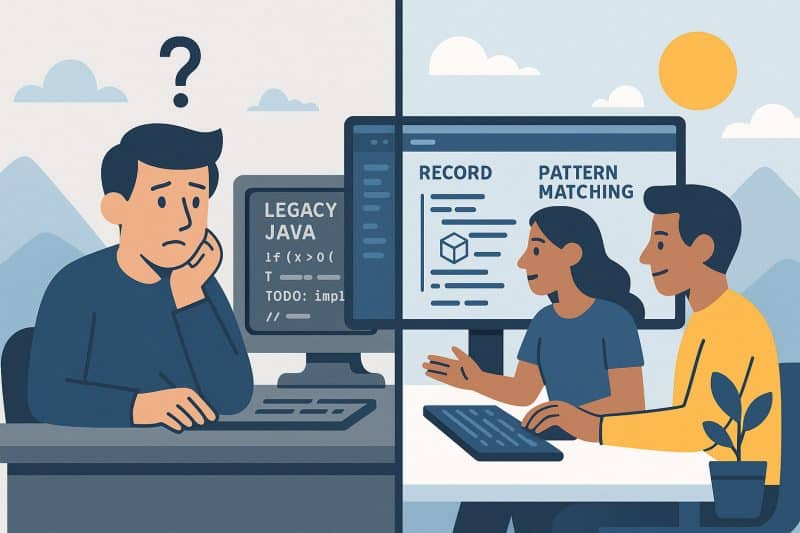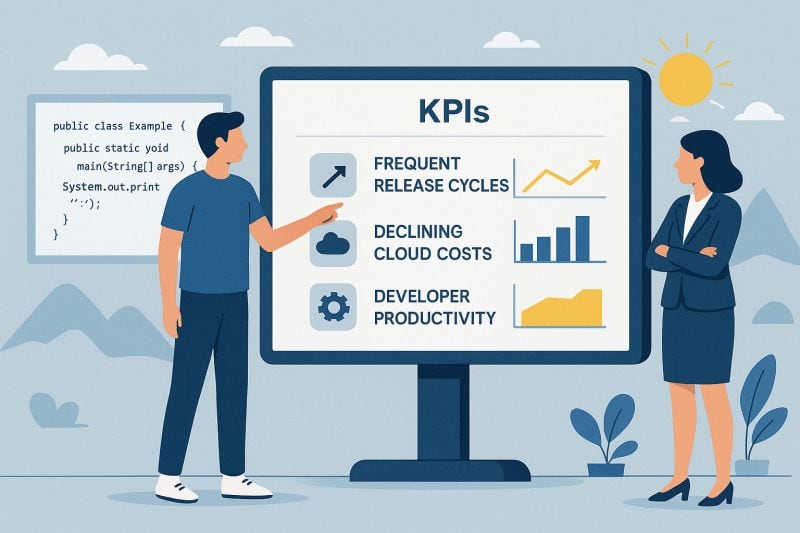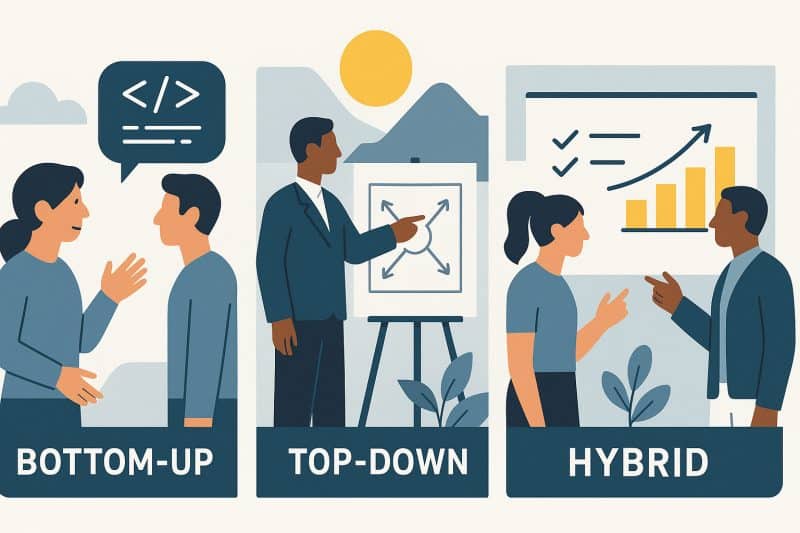

You probably know this: A new Java version is just around the corner – and while one or two team members are enthusiastic, the rest remain rather reserved or even block it. Even in management, enthusiasm is often limited when it comes to modernization, upgrades or investments in developer skills. After all, everything works somehow – and “Never change a running system” is a proven motto.
But once you've experienced how much more fun modern Java features make in everyday life, how much they speed up development, make code clearer and noticeably conserve resources, you won't want to miss these advantages. The problem: To get modernization going, you need everyone on board – your team and the decision-makers.
In this article, you'll learn how to convince both sides – with the right arguments, practical examples and concrete tips from everyday project work. Whether you're passionate about an upgrade yourself or want to take your team with you as a manager: Here you'll learn how modernization succeeds – and everyone wins.
Why It's Often Difficult to get Everyone on Board with Java Modernization
Although modern Java versions bring numerous advantages – faster development, better readable code, more efficient use of resources – the path to modernization in many teams is not without obstacles. A field of tension often arises between developers who are enthusiastic about new language features such as Records, Pattern Matching or Virtual Threads, and colleagues who hesitate or are fundamentally skeptical of change.
On the other hand, there is management: Investments in upgrades, training or modernization measures must be justified in a comprehensible manner. The central question is usually: How great is the benefit in relation to the effort? Without clear answers – such as falling cloud costs, shorter release cycles or higher developer productivity – there is also a lack of willingness to invest, and modernization projects are put on the back burner.
Typical patterns that I see again and again in projects:
- Some team members are driving new features and improvements, but are met with reluctance or uncertainty in the rest of the team.
- The management level remains cautious as long as the existing code works and no critical incidents occur.
- There is uncertainty as to whether modern features are really stable – or change the existing code base too much.
- More urgent projects and day-to-day business repeatedly push modernization out of focus.
The consequence:
Innovation potentials remain unused, technical debts grow, and the concrete advantages of modern Java versions remain theory. This affects not only technical aspects – but also the motivation and further development of the team.
In the next sections, I'll show you how to break through this dynamic: with arguments that resonate with the team, and with a language that convinces decision-makers – so that modernization is understood and supported as a joint project.
The Dynamics in the Team: What Slows down, What Motivates?
Every modernization project brings movement into the team – in the best case motivation, in the worst case uncertainty or even resistance. This dynamic is quite normal, because technical changes affect not only the code, but also established routines, ways of thinking and sometimes even the self-image as a developer.
What slows you down?
- Fear of extra effort: New language features mean training. Anyone who is already under time pressure fears additional stress – especially when deadlines are looming.
- Unclear benefits: If it is not visible how new features specifically affect your own project, the motivation remains low. Theory alone rarely convinces.
- Stability and security: Many developers rely on proven solutions. “What we know works” – this thinking is understandable, but risky in the long run.
- Heterogeneous levels of knowledge: There is often a wide range in the team: While some are already experimenting with the new features, others have remained with Java 8.
- Complexity of the code base: Especially when the existing code has grown historically and is difficult to understand, people shy away from changes – for fear of breaking something.

What motivates?
- Visible improvements: If modern features make the code leaner, reduce sources of errors or make tasks more efficient, interest grows quickly.
- Joint learning: Exchange within the team – for example through coding sessions or internal dojos – creates a positive learning culture and reduces fears.
- Quick wins: Even small modernizations with a measurable effect, e.g. reduced boilerplate or better readable code, often have a more convincing effect than any PowerPoint presentation.
- Recognition and further development: Anyone who contributes new things and implements them successfully strengthens their own role in the team – and promotes their own development.
- Clear benefits in everyday life: Modern Java features ensure a more understandable syntax and help to express intentions in the code more precisely – the code becomes easier to read and maintain for everyone.
Conclusion:
The motivation for modernization does not arise from regulations – but from tangible improvements and a common understanding. The better you address uncertainties in the team and make concrete advantages visible, the easier it will be to get everyone on board.
In the next step, we'll take a look at how you can specifically get your team excited about modern Java versions – and which arguments work best.
Convincing your Team: how to Make Them Want Modern Java Versions
If there is skepticism in the team or the benefits of new Java versions are not yet tangible, it takes more than an abstract feature list. It is crucial that the advantages can be experienced in your own everyday life – and that no one feels overwhelmed or left alone.
Which arguments are really convincing?
- Less boilerplate, more clarity: Modern features such as Records, Pattern Matching or Switch Expressions help to significantly reduce redundant code. This makes applications leaner, more understandable – and saves time in development, reviews and maintenance.
- Express intention more precisely – with modern syntax: New language tools make it possible to map complex business logic more clearly. The code becomes more self-explanatory, less error-prone and still easy to understand months later – for yourself and for your colleagues.
- Performance and resource consumption: New Java versions bring continuous optimizations in execution – for example through modern garbage collectors or improvements in the hotspot compiler. The result: better performance without changes to the code.
- Asynchronous logic – without reactive complexity: Virtual threads enable a simple, imperative structure – with simultaneous scalability. Instead of complex reactive frameworks, classic code can often be used, which is more readable and maintainable.
- Motivation and further development: Current tools and language features bring a breath of fresh air into everyday development. It's simply more fun to develop yourself further with current techniques – this strengthens motivation, competence and employer attractiveness.
- Quick wins: Even small changes – such as a first refactoring to records or a more elegant pattern matching – show how clarity and maintainability can be improved. Such quick wins are often more convincing than any theoretical presentation.

How to get your team on board:
- Start with realistic dry runs: Even if the project is (still) running on an older Java version, you can show in a separate branch how a piece of legacy code can be improved with modern language tools – initially without interfering with CI/CD or deployment.
- Use brown bag sessions: Informal short formats during the lunch break are perfect for sharing knowledge in a relaxed and pressure-free way.
- Create space for questions and exchange: Not everyone gets through immediately. Encourage them to ask questions openly and express uncertainties – for example in team meetings, internal forums or Slack channels.
- Focus on joint learning: Organize small coding sessions or dojos in which the team tries out new features together. This often leads to new ideas, and enthusiasm spills over to others.
- Actively involve skeptics: Encourage critical voices to formulate their concerns. Often a convincing example is enough to turn doubt into interest.
- Make progress visible: Record successes – for example with a small “Hall of Fame” for particularly successful code modernizations. Visible successes motivate – and invite imitation.
Conclusion:
Your team not only needs to know modern Java versions – it needs to feel their value. If you show how new language features noticeably improve everyday life, motivation, curiosity and willingness to learn arise all by themselves. The rest is a process – but one that is worthwhile.
The next chapter is about how to convince management – with arguments that translate technology into business benefits.
Inspiring Management: Translating Technology into Business Benefits
Even the most motivated development team reaches its limits when support from management is lacking. Investments in modernization, training or new tools must assert themselves against other priorities. That's why it's crucial not only to justify technical innovations technically – but to show their concrete benefits for the business.
What convinces decision-makers?
- Measurable results: Show how modernization affects concrete KPIs – for example through shorter release cycles, fewer failures or higher productivity in the team. Before-and-after comparisons from pilot projects or simple time/cost estimates are often particularly convincing.
- Reduced costs: Modern Java versions can significantly reduce resource requirements through targeted JVM optimizations and improved garbage collectors. Less CPU load, lower memory consumption and faster start-up times lead directly to lower cloud costs.
- Competitive advantages: An up-to-date technology stack not only increases the speed of innovation, but also makes the company more attractive to new talent. Those who use modern tools can develop new features faster and react more flexibly to market changes.
- Future security: Regular updates and modern language elements reduce technical ballast. This reduces the risk of security vulnerabilities and compliance problems. Maintenance becomes more predictable – and cheaper in the long run.
- Risk and error reduction: Modern code is more readable, more understandably structured and less prone to errors. Bugs are found faster, downtimes are reduced and support costs are lowered.

How do you argue effectively?
- Speak the language of management: Focus on business metrics, not technical details. Instead of “Pattern Matching is more elegant” rather: “We reduce development time and lower maintenance costs through clearer code.” Instead of “ZGC enables low-pause garbage collection” better: “Customers experience fewer dropouts and faster response times – a measurable competitive advantage.”
- Use practical examples: Show how similar companies or other teams in your own company have benefited from modernization. You can find a selection of impressive examples in the box “Concrete practical examples” at the end of the section.
- Prepare decision templates: Summarize benefits, effort and possible risks in a compact way. A well-structured presentation or a compact PDF can already make the difference.
- Show the Return on Investment (ROI): Show how quickly the investment in an upgrade or training pays for itself – for example through savings, faster time-to-market or fewer support tickets.
- Offer concrete next steps: A non-binding modernization workshop or targeted proof of concept quickly delivers initial results and makes the benefits of new features tangible – without changing existing processes.
Conclusion:
Management rarely decides purely technically – it needs comprehensible figures, risks and opportunities. If you manage to translate the technical added value of modern Java development into measurable, entrepreneurial advantages, you create the basis for willingness to invest and strategic support.
In the next chapter, we'll take a look at which path to modernization might be the best fit for your company – bottom-up, top-down or together.
Concrete practical examples: This is how Java modernization works in reality
- Alibaba was able to increase throughput by up to 20% and reduce latency by up to 60% by upgrading from Java 8 to 17 (source).
- Netflix reports savings in the six- to seven-figure range by switching to Spring Boot 3 and Java 17 (source).
- Amazon saves around USD 260 million annually by switching to Java 17 and the associated performance optimizations (source).
- Very Good Security (VGS) reduced the number of garbage collections by up to 87.5% by upgrading to Java 17 – with 50% less cumulative GC pause time (source).
- Netflix was able to reduce the maximum response time from 2500 ms to under 1 ms by upgrading to Java 21 and using the Generational ZGC (source).
- Amazon reduced memory consumption by up to 22% by using Compact Object Headers (Java 25) – with 11% higher throughput (source).
- In a JetBrains study, 52% of developers stated that outdated technology significantly complicates their daily work – in a StackOverflow survey, it was even 58% (source).
- According to a Storyblok survey, 58% of developers considered changing jobs last year because of an outdated tech stack. 73% know colleagues who have already quit for this reason. 74% say that the stack they use significantly shapes their professional identity (source).
- The same article says: Employers pay a “legacy surcharge” – in the form of higher salaries or external consultants, just to be able to continue operating old systems.
- Ryan Morgan, Senior Director by VMware says aptly: “There is no better ROI than being on the latest version.” (source).
Which Path Suits You? Bottom-up, Top-Down – or Together?
As soon as the desire for modernization is in the room, the question arises: How do you best get the change rolling? Do you wait for a clear signal from above, do you start yourself in the team – or do you look for a common path with management? Each of these approaches has strengths and weaknesses. The most effective is often a clever combination.
Bottom-up: the Initiative from the Team
Many successful modernization projects arise because individual developers or small groups take the first step. They try out new features, prepare examples and present them in the team or company-wide in brownbag sessions.
Benefits:
- Practical examples and quick wins are often more convincing than abstract arguments.
- The team develops initiative and motivation.
- Acceptance is usually higher because the change arises from everyday work.
Risks:
- Without backing from management, important resources or budgets are often lacking.
- Changes may remain limited to individual projects and not reach the entire company.
Top-down: Management Sets the Direction
In some companies, the initiative comes from management. The leadership strategically decides on an upgrade and implements the modernization course in a binding manner.
Benefits:
- Resources and budgets are secured.
- The direction is clear and consistent – even across team boundaries.
- Decisions can be made and implemented more quickly.
Risks:
- If the team is not involved, resistance can easily arise – the project seems like a measure imposed from above.
- Without technical expertise in the decision-making process, important framework conditions from the developers' everyday work might not be sufficiently considered.

Strong Together: the Hybrid Approach
The best results are achieved when bottom-up engagement and top-down support go hand in hand. The team contributes ideas and concrete use cases – the management provides the structural framework, resources, freedom, and creates strategic commitment.
How to make the collaboration succeed:
- Early, open communication between tech leads, the team, and the management level.
- Jointly defined pilot projects that consider both technical and economic goals.
- Feedback loops: Experiences from the team are systematically incorporated into further planning and prioritization.
- Visible successes – for example, through small lighthouse projects that also inspire other teams.
Conclusion:
Whether bottom-up, top-down, or together – the crucial thing is that all participants are picked up, involved, and empowered early on. Change does not succeed through pressure, but through understanding, participation, exchange, and initial positive experiences.
In the next chapter, I'll show you how you can actively shape this process – and how you can use it to build a sustainable culture of change.
Conclusion: Start Now – and Bring Everyone Along
The introduction of modern Java versions is not a sure thing – but it is worth it. If you manage to inspire both your team and management with the advantages, you create the basis for sustainable progress: more maintainable code, motivated developers, and visible business advantages.

The most important learnings at a glance:
- Show real benefits in everyday work: Features like Records, Pattern Matching, or Virtual Threads are convincing not through theory, but through concrete simplifications in everyday work.
- Speak openly about concerns: Uncertainties are normal. A learning culture in which questions are welcome creates trust and openness to new things.
- Translate technical advantages into business language: Decision-makers want to see results – lower cloud costs, higher velocity, decreasing maintenance effort.
- Rely on pilot projects and quick wins: First small modernizations – visible, tangible, low-risk – create trust and motivation for the next steps.
- Understand modernization as a process: Not a “Big Bang”, but a structured path. With a clear roadmap, iterative implementation, and continuous learning support.
Most importantly: Just start – with a small step. You don't have to modernize everything at once. Even a small example, a brownbag session, or an exploration branch can be the beginning. Share your experiences, involve others – and stick with it, even if there are setbacks.
Every step creates clarity, trust, and direction – and brings you and your team closer to a modern, maintainable, future-proof Java project.
Do you have questions, need concrete arguments for your next meeting, or want to initiate a modernization project?
Feel free to write to me or bring your experiences and ideas to the comments – I look forward to the exchange!
